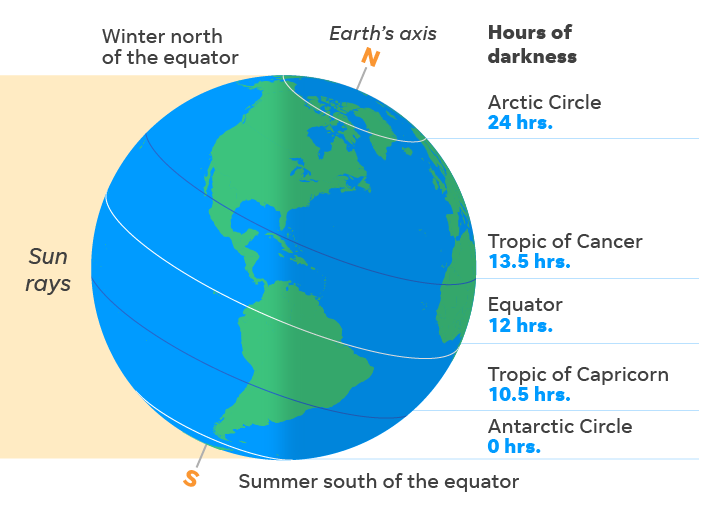|
The winter solstice, the shortest day of the year, occurs in the northern hemisphere between December 20 and 23. This year, it happens on Monday, December 21. From USA Today: "The winter solstice is the precise moment at which the Northern Hemisphere is tilted farthest from the sun. The solstice occurs at the same instant everywhere on Earth: Here in the United States, it happens at 5:02 a.m. ET on Dec. 21. At that moment, the sun's rays are directly over the Tropic of Capricorn, a line of latitude that circles the Earth in the Southern Hemisphere. Though the solstice marks the astronomical beginning of winter, meteorologists view winter as starting Dec. 1, which is the start of the coldest three months in the Northern Hemisphere." This year, stargazers have a couple things to look forward to in the longest-of-the-year night sky. The "Great Conjunction" occurs Monday evening, where the planets Jupiter and Saturn will appear to cross paths in the sky. According to NASA, "It’s been nearly 400 years since the planets passed this close to each other in the sky, and nearly 800 years since the alignment of Saturn and Jupiter occurred at night, as it will for 2020, allowing nearly everyone around the world to witness this 'great conjunction.'" To view the conjunction in western Iowa, look southwest after sunset. The planets will be visible above the horizon between about 5:30 and 7:30pm CST. Later in the evening into Tuesday morning, the last meteor shower of 2020, the Ursids, will be visible. While often overshadowed by the Geminid meteor shower that peaked a week earlier, the Ursids are still worth a look. "Observers will normally see 5-10 Ursids per hour during the late morning hours on the date of maximum activity...There have been occasional outbursts when rates have exceeded 25 per hour" (Source: Accuweather). The Ursids will "radiate" from near Ursa Minor ("Little Dipper"), meaning the best viewing will be looking north towards Polaris and the Big and Little Dippers. To view these celestial events, find a dark place away from urban and industrial light pollution. Some parts of the Loess Hills, especially in Harrison and Monona counties, are good places to view the night sky. Several areas along Western Skies Scenic Byway are also good places to avoid light pollution. Whiterock Conservancy is recognized as one of the darkest places in Iowa. If you don't like the darkness, don't worry--the days will slowly get longer from now until next June!
0 Comments
Leave a Reply. |
Archives
June 2024
Categories
All
|
Address712 South Highway Street
P.O. Box 189 Oakland, IA 51560 |
ContactPhone: 712-482-3029
General inquiries: [email protected] Visit our Staff Page for email addresses and office hours. |





 RSS Feed
RSS Feed